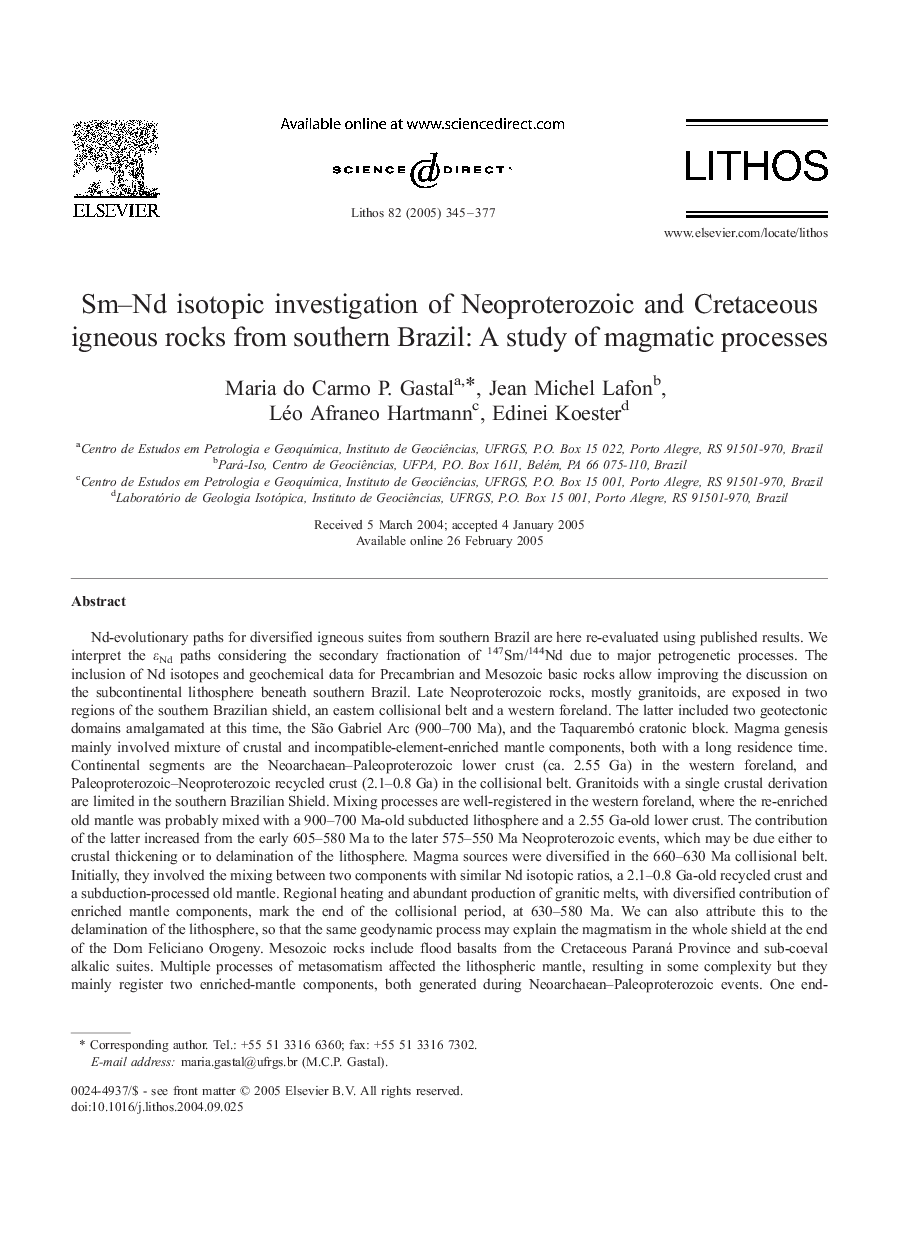| کد مقاله | کد نشریه | سال انتشار | مقاله انگلیسی | نسخه تمام متن |
|---|---|---|---|---|
| 9531857 | 1638791 | 2005 | 33 صفحه PDF | دانلود رایگان |
عنوان انگلیسی مقاله ISI
Sm-Nd isotopic investigation of Neoproterozoic and Cretaceous igneous rocks from southern Brazil: A study of magmatic processes
دانلود مقاله + سفارش ترجمه
دانلود مقاله ISI انگلیسی
رایگان برای ایرانیان
کلمات کلیدی
موضوعات مرتبط
مهندسی و علوم پایه
علوم زمین و سیارات
ژئوشیمی و پترولوژی
پیش نمایش صفحه اول مقاله

چکیده انگلیسی
Nd-evolutionary paths for diversified igneous suites from southern Brazil are here re-evaluated using published results. We interpret the εNd paths considering the secondary fractionation of 147Sm/144Nd due to major petrogenetic processes. The inclusion of Nd isotopes and geochemical data for Precambrian and Mesozoic basic rocks allow improving the discussion on the subcontinental lithosphere beneath southern Brazil. Late Neoproterozoic rocks, mostly granitoids, are exposed in two regions of the southern Brazilian shield, an eastern collisional belt and a western foreland. The latter included two geotectonic domains amalgamated at this time, the São Gabriel Arc (900-700 Ma), and the Taquarembó cratonic block. Magma genesis mainly involved mixture of crustal and incompatible-element-enriched mantle components, both with a long residence time. Continental segments are the Neoarchaean-Paleoproterozoic lower crust (ca. 2.55 Ga) in the western foreland, and Paleoproterozoic-Neoproterozoic recycled crust (2.1-0.8 Ga) in the collisional belt. Granitoids with a single crustal derivation are limited in the southern Brazilian Shield. Mixing processes are well-registered in the western foreland, where the re-enriched old mantle was probably mixed with a 900-700 Ma-old subducted lithosphere and a 2.55 Ga-old lower crust. The contribution of the latter increased from the early 605-580 Ma to the later 575-550 Ma Neoproterozoic events, which may be due either to crustal thickening or to delamination of the lithosphere. Magma sources were diversified in the 660-630 Ma collisional belt. Initially, they involved the mixing between two components with similar Nd isotopic ratios, a 2.1-0.8 Ga-old recycled crust and a subduction-processed old mantle. Regional heating and abundant production of granitic melts, with diversified contribution of enriched mantle components, mark the end of the collisional period, at 630-580 Ma. We can also attribute this to the delamination of the lithosphere, so that the same geodynamic process may explain the magmatism in the whole shield at the end of the Dom Feliciano Orogeny. Mesozoic rocks include flood basalts from the Cretaceous Paraná Province and sub-coeval alkalic suites. Multiple processes of metasomatism affected the lithospheric mantle, resulting in some complexity but they mainly register two enriched-mantle components, both generated during Neoarchaean-Paleoproterozoic events. One end-member has a more pronounced subduction signature. The other one probably resulted from the re-enrichment of the first component at the end of the Camboriú collisional orogeny (â¼2.0 Ga).
ناشر
Database: Elsevier - ScienceDirect (ساینس دایرکت)
Journal: Lithos - Volume 82, Issues 3â4, June 2005, Pages 345-377
Journal: Lithos - Volume 82, Issues 3â4, June 2005, Pages 345-377
نویسندگان
Maria do Carmo P. Gastal, Jean Michel Lafon, Léo Afraneo Hartmann, Edinei Koester,